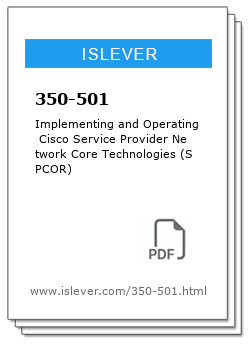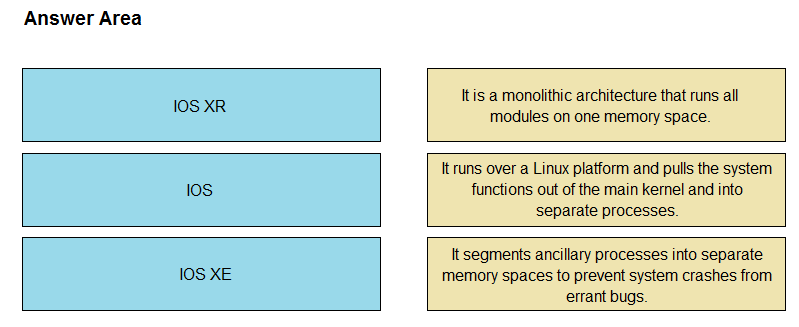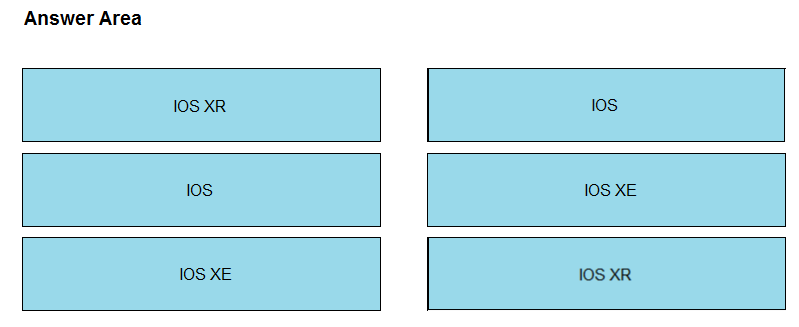Description

Exam 350-501: Implementing and Operating Cisco Service Provider Network Core Technologies (SPCOR)
|
Unlock the Shortcut to Quick Exam Success with 350-501 Mock Tests! Tried and tested by countless students, our 350-501 Tests are your express ticket to acing the 350-501 exam. Packed with the latest exam questions and answers, these study materials are designed to save you precious time and energy. Say goodbye to the stress of exam preparation and hello to your coveted certification. Our study materials come in PDF format, featuring a comprehensive collection of exam questions. Implementing and Operating Cisco Service Provider Network Core Technologies (SPCOR). Master these questions, and you're well on your way to passing the exam with flying colors. |
DEMO
Question #1
DRAG DROP -
Drag and drop the OSs from the left onto the correct descriptions on the right.
Select and Place:

Answer:

Question #2

Refer to the exhibit. P3 and PE4 are at the edge of the service provider core and serve as ABR routers. Aggregation areas are on either side of the core.
Which statement about the architecture is true?
- A. To support seamless MPLS, the BGP route reflector feature must be disabled.
- B. If each area is running its own IGP, BGP must provide an end-to-end MPLS LSP.
- C. If each area is running its own IGP, the ABR routers must redistribute the IGP routing table into BGP.
- D. To support seamless MPLS, TDP must be used as the label protocol.
Answer: B
Question #3
Which component is similar to an EVPN instance?
- A. router distinguisher
- B. MPLS label
- C. IGP router ID
- D. VRF
Answer: D
Question #4
Why do Cisco MPLS TE tunnels require a link-state routing protocol?
- A. The link-state database provides segmentation by area, which improves the path-selection process.
- B. The link-state database provides a data repository from which the tunnel endpoints can dynamically select a source ID.
- C. Link-state routing protocols use SPF calculations that the tunnel endpoints leverage to implement the tunnel.
- D. The tunnel endpoints use the link-state database to evaluate the entire topology and determine the best path.
Answer: D
Question #5
You are configuring MPLS traffic-engineering tunnels in the core. Which two ways exist for the tunnel path across the core? (Choose two.)
- A. The dynamic path option is supported only with IS-IS.
- B. Tunnels can be configured with dynamic path or explicitly defined path.
- C. A zero bandwidth tunnel is not a valid option.
- D. The bandwidth statement creates a ג€hardג€ reservation on the link.
- E. Tunnel links inherit IGP metrics by default unless overridden.
Answer: BE
Question #6
Which configuration mode do you use to apply the mpls ldp graceful-restart command in IOS XE Software?
- A. MPLS LDP neighbor
- B. interface
- C. MPLS
- D. global
Answer: D
Question #7 ... 404
Implementing and Operating Cisco Service Provider Network Core Technologies (SPCOR)
Note: The 350-501 DEMO includes only a small portion of the actual product content. To access the complete material, please consider purchasing the product. Upon purchase, you'll receive a PDF file containing the entire content.
Additionally, our 350-501 brain dumps has been curated to exclude outdated, invalid, and erroneous information, ensuring a more effective learning experience for you.